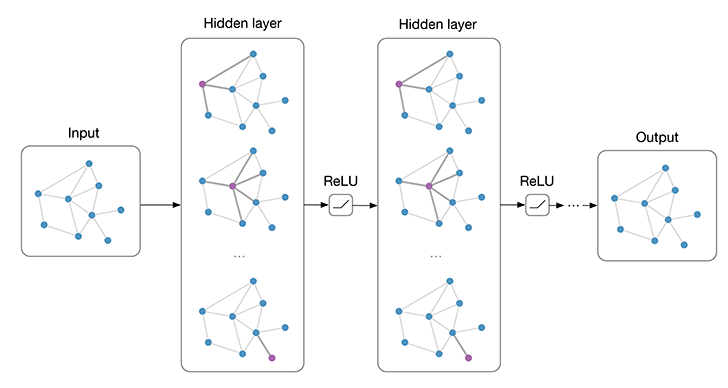本文主要是介绍【DGL】节点分类(GCN、SAGE、自定义),希望对大家解决编程问题提供一定的参考价值,需要的开发者们随着小编来一起学习吧!
目录
- 使用dgl进行节点分类(GCN)
- 数据集
- 搭建网络
- 训练
- 使用dgl进行节点分类(SAGE)
- 实现SAGE
- 引入边权
- 更多自定义操作
使用dgl进行节点分类(GCN)
数据集
dataset = dgl.data.CoraGraphDataset()
print("Number of categories:", dataset.num_classes)
g = dataset[0]
数据集信息:
Cora dataset,引用网络图,其中,节点表示论文,边表示论文的引用。任务是预测给定论文的类别。
NumNodes: 2708NumEdges: 10556NumFeats: 1433NumClasses: 7NumTrainingSamples: 140NumValidationSamples: 500NumTestSamples: 1000
Done loading data from cached files.
Number of categories: 7
其中,含有一个graph:
Graph(num_nodes=2708, num_edges=10556,ndata_schemes={'train_mask': Scheme(shape=(), dtype=torch.bool), 'label': Scheme(shape=(), dtype=torch.int64), 'val_mask': Scheme(shape=(), dtype=torch.bool), 'test_mask': Scheme(shape=(), dtype=torch.bool), 'feat': Scheme(shape=(1433,), dtype=torch.float32)}edata_schemes={})
train_mask: A boolean tensor indicating whether the node is in the training set.
val_mask: A boolean tensor indicating whether the node is in the validation set.
test_mask: A boolean tensor indicating whether the node is in the test set.
label: The ground truth node category.
feat: The node features.
搭建网络
根据Graph Convolutional Network (GCN)搭建两层的图卷积神经网络。每一层通过聚合邻居节点的信息来计算新的节点表示。

class GCN(nn.Module):def __init__(self, in_feats, h_feats, num_classes):super(GCN, self).__init__()self.conv1 = GraphConv(in_feats, h_feats)self.conv2 = GraphConv(h_feats, num_classes)def forward(self, g, in_feat):h = self.conv1(g, in_feat)h = F.relu(h)h = self.conv2(g, h)return hmodel = GCN(g.ndata['feat'].shape[1], 16, dataset.num_classes)
print(model)
数学上表示成1: h i ( l + 1 ) = σ ( b ( l ) + ∑ j ∈ N ( i ) 1 c j i h j ( l ) W ( l ) ) h_i^{(l+1)} = \sigma(b^{(l)} + \sum_{j\in\mathcal{N}(i)}\frac{1}{c_{ji}}h_j^{(l)}W^{(l)}) hi(l+1)=σ(b(l)+j∈N(i)∑cji1hj(l)W(l))
模型结构:
GCN((conv1): GraphConv(in=1433, out=16, normalization=both, activation=None)(conv2): GraphConv(in=16, out=7, normalization=both, activation=None)
)
训练
def train(g, model):optimizer = torch.optim.Adam(model.parameters(), lr=0.01)best_val_acc = 0best_test_acc = 0features = g.ndata['feat']labels = g.ndata['label']train_mask = g.ndata['train_mask']val_mask = g.ndata['val_mask']test_mask = g.ndata['test_mask']for e in range(100):logits = model(g, features)pred = logits.argmax(1)loss = F.cross_entropy(logits[train_mask], labels[train_mask])train_acc = (pred[train_mask] == labels[train_mask]).float().mean()val_acc = (pred[val_mask] == labels[val_mask]).float().mean()test_acc = (pred[test_mask] == labels[test_mask]).float().mean()if(best_val_acc < val_acc):best_val_acc = val_accbest_test_acc = test_accoptimizer.zero_grad()loss.backward()optimizer.step()if(e%5==0):print("In epoch {}, loss: {:.3f}, val acc: {:.3f} (best {:.3f}), test acc: {:.3f} (best {:.3f})".format(e, loss, val_acc, best_val_acc, test_acc, best_test_acc))train(g, model)
In epoch 0, loss: 1.946, val acc: 0.240 (best 0.240), test acc: 0.254 (best 0.254)
In epoch 5, loss: 1.903, val acc: 0.642 (best 0.642), test acc: 0.639 (best 0.639)
In epoch 10, loss: 1.837, val acc: 0.696 (best 0.700), test acc: 0.711 (best 0.715)
In epoch 15, loss: 1.746, val acc: 0.674 (best 0.700), test acc: 0.685 (best 0.715)
In epoch 20, loss: 1.628, val acc: 0.694 (best 0.700), test acc: 0.710 (best 0.715)
In epoch 25, loss: 1.484, val acc: 0.690 (best 0.700), test acc: 0.715 (best 0.715)
In epoch 30, loss: 1.321, val acc: 0.710 (best 0.710), test acc: 0.732 (best 0.732)
In epoch 35, loss: 1.144, val acc: 0.714 (best 0.720), test acc: 0.738 (best 0.737)
In epoch 40, loss: 0.966, val acc: 0.730 (best 0.730), test acc: 0.742 (best 0.742)
In epoch 45, loss: 0.797, val acc: 0.742 (best 0.742), test acc: 0.745 (best 0.745)
In epoch 50, loss: 0.647, val acc: 0.756 (best 0.756), test acc: 0.756 (best 0.756)
In epoch 55, loss: 0.520, val acc: 0.762 (best 0.762), test acc: 0.759 (best 0.759)
In epoch 60, loss: 0.416, val acc: 0.768 (best 0.768), test acc: 0.767 (best 0.765)
In epoch 65, loss: 0.334, val acc: 0.762 (best 0.768), test acc: 0.771 (best 0.765)
In epoch 70, loss: 0.270, val acc: 0.758 (best 0.768), test acc: 0.774 (best 0.765)
In epoch 75, loss: 0.220, val acc: 0.760 (best 0.768), test acc: 0.777 (best 0.765)
In epoch 80, loss: 0.182, val acc: 0.764 (best 0.768), test acc: 0.779 (best 0.765)
In epoch 85, loss: 0.151, val acc: 0.764 (best 0.768), test acc: 0.780 (best 0.765)
In epoch 90, loss: 0.128, val acc: 0.764 (best 0.768), test acc: 0.782 (best 0.765)
In epoch 95, loss: 0.109, val acc: 0.766 (best 0.768), test acc: 0.779 (best 0.765)Process finished with exit code 0使用dgl进行节点分类(SAGE)
dgl遵循消息传递网络范式2。GraphSAGE convolution (Hamilton et al., 2017)具有以下形式:
h N ( v ) k ← A v e r a g e { h u k − 1 , ∀ u ∈ N ( v ) } h v k ← R e L U ( W k ⋅ C O N C A T ( h v k − 1 , h N ( v ) k ) ) h_\mathcal{N(v)}^k \gets Average\{ h_u ^{k-1} , \forall u \in \mathcal{N}(v) \} \\ h_v^k \gets ReLU(W^k \cdot CONCAT(h_v^{k-1}, h^k _{\mathcal{N}(v)})) hN(v)k←Average{huk−1,∀u∈N(v)}hvk←ReLU(Wk⋅CONCAT(hvk−1,hN(v)k))
实现SAGE
在dgl中有内置的SAGEConv。下面来自己实现:
class SAGEConv(nn.Module):def __init__(self, in_feat, out_feat):super(SAGEConv, self).__init__()# A linear submodule for projecting the input and neighbor feature to the output.self.linear = nn.Linear(in_feat*2, out_feat) # Wdef forward(self, g, h):with g.local_scope():#在这个区域内对g的修改不会同步到原始的图上g.ndata['h'] = hg.update_all( #对所有的节点和边采用下面的message函数和reduce函数message_func=fn.copy_u("h", "m"), #message函数:将节点特征'h'作为消息传递给邻居,命名为'm'reduce_func=fn.mean("m", "h_N"), #reduce函数:将接收到的'm'信息取平均,保存至节点特征'h_N')h_N = g.ndata["h_N"]h_total = torch.cat([h, h_N], dim=1)return self.linear(h_total)
依此搭建新的网络:
class Model(nn.Module):def __init__(self, in_feats, h_feats, num_classes):super(Model, self).__init__()self.conv1 = SAGEConv(in_feats, h_feats)self.conv2 = SAGEConv(h_feats, num_classes)def forward(self, g, in_feat):h = self.conv1(g, in_feat)h = F.relu(h)h = self.conv2(g, h)return hmodel = Model(g.ndata['feat'].shape[1], 16, dataset.num_classes)
效果和GCN差不多吧
引入边权
class WeightedSAGEConv(nn.Module):def __init__(self, in_feat, out_feat):super(WeightedSAGEConv, self).__init__()# A linear submodule for projecting the input and neighbor feature to the output.self.linear = nn.Linear(in_feat * 2, out_feat)def forward(self, g, h, w):with g.local_scope():g.ndata["h"] = hg.edata["w"] = wg.update_all(message_func=fn.u_mul_e("h", "w", "m"), #节点特征'h' 与 邻居间的边特征'w' 的乘积作为消息传递给邻居,记作'm'reduce_func=fn.mean("m", "h_N"), #将接收到的'm'信息取平均,保存至节点特征'h_N')h_N = g.ndata["h_N"]h_total = torch.cat([h, h_N], dim=1)return self.linear(h_total)class Model(nn.Module):def __init__(self, in_feats, h_feats, num_classes):super(Model, self).__init__()self.conv1 = WeightedSAGEConv(in_feats, h_feats)self.conv2 = WeightedSAGEConv(h_feats, num_classes)def forward(self, g, in_feat):h = self.conv1(g, in_feat, torch.ones(g.num_edges(), 1).to(g.device))#数据中没有边特征,在这里手动添加h = F.relu(h)h = self.conv2(g, h, torch.ones(g.num_edges(), 1).to(g.device))return hmodel = Model(g.ndata["feat"].shape[1], 16, dataset.num_classes)
更多自定义操作
见dgl.function
内置函数 dgl.function.u_add_v('hu','hv',' he')等价于:
def message_func(edges):#返回值为字典形式return {'he': edges.src['hu'] + edges.dst['hv']}
https://docs.dgl.ai/generated/dgl.nn.pytorch.conv.GraphConv.html#dgl.nn.pytorch.conv.GraphConv ↩︎
Neural Message Passing for Quantum Chemistry ↩︎
这篇关于【DGL】节点分类(GCN、SAGE、自定义)的文章就介绍到这儿,希望我们推荐的文章对编程师们有所帮助!





